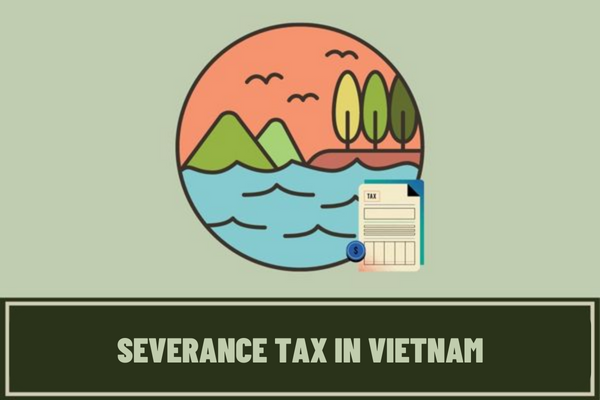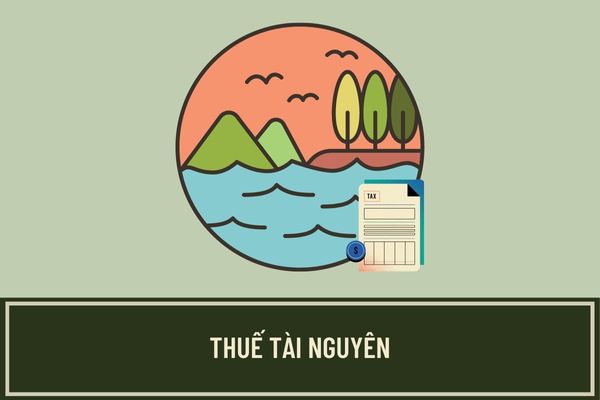What are the current severance tax rates in Vietnam? Which cases are exempt from severance tax in Vietnam?
What are the current severance tax rates in Vietnam?
Pursuant to Article 7 of the 2009 Law on Severance Tax in Vietnam stipulating severance tax rates as follows:
No. | Group or category of natural resource | Severance tax rate (%) |
I | Metallic minerals |
|
1 | Iron and manganese | 7-20 |
2 | Titan | 7-20 |
3 | Gold | 9-25 |
4 | Rare earths | 12-25 |
5 | Platinum, silver and tin | 7-25 |
6 | Wolfram and antimony | 7-25 |
7 | Lead, zinc, aluminum, bauxite, copper and nickel | 7-25 |
8 | Cobalt, molybdenum, mercury, magnesium and vanadium | 7-25 |
9 | Other metallic minerals | 5-25 |
II | Non-metallic minerals |
|
1 | Soil exploited for ground leveling and work construction | 3-10 |
2 | Rock, except rock used for lime baking and cement production; gravel; sand, except sand used for glass-making | 5-15 |
3 | Soil used for brick-making | 5-15 |
4 | Granite and refractory clay | 7-20 |
5 | Dolomite and quartzite | 7-20 |
6 | Kaolin, mica, technical quartz, and sand used for glass-making | 7-15 |
7 | Pyrite, phosphorite, and stone for lime baking and cement production | 5-15 |
8 | Apatite and serpentine | 3-10 |
9 | Pit anthracite coal | 4-20 |
10 | Open-cast anthracite coal | 6-20 |
11 | Lignite and fat coal | 6-20 |
12 | Other coals | 4-20 |
13 | Diamond, ruby and sapphire | 16-30 |
14 | Emerald, alexandrite and black precious opal | 16-30 |
15 | Adrite, rodolite, pyrope, berine. Spinel and topaz | 12-25 |
16 | Bluish-purple, greenish-yellow or orange crystalline quartz; chrysolite; white or scarlet precious opal; feldspar; birusa; and nephrite | 12-25 |
17 | Other non-metallic minerals | 4-25 |
III | Crude oil | 6-40 |
IV | Natural gas and coal gas | 1-30 |
V | Natural forest products |
|
1 | Timber of group I | 25-35 |
2 | Timber of group II | 20-30 |
3 | Timber of groups III and IV | 15-20 |
4 | Timber of groups V, VI, VII and VIII and of other categories | 10-15 |
5 | Tree branches, tops, stumps and roots | 10-20 |
6 | Firewood | 1-5 |
7 | Bamboo of all kinds | 10-15 |
8 | Sandalwood and calambac | 25-30 |
9 | Anise, cinnamon, cardamom and liquorice | 10-15 |
10 | Other natural forest products | 5-15 |
| Natural aquatic resources |
|
1 | Pearl, abalone and sea-cucumber | 6-10 |
2 | Other natural aquatic resources | 1-5 |
VII | Natural water |
|
1 | Natural mineral water, natural thermal water and refined natural water, bottled or tinned | 8-10 |
2 | Natural water used for hydropower generation | 2-5 |
3 | Natural water used for production and business activities, except water mentioned at Points 1 and 2 of this group |
|
3.1 | .Surface water | 1-3 |
3.2 | Groundwater | 3-8 |
VIII | Natural swallow's nests | 10-20 |
IX | Other resources | 1-20 |
Note: Specific severance tax rates for crude oil, natural gas and coal gas shall be determined as partially progressive based on their daily exploited average output.

What are the current severance tax rates in Vietnam? Which cases are exempt from severance tax in Vietnam?
Which cases are exempt from severance tax in Vietnam?
Pursuant to Article 9 of the 2009 Law on Severance Tax in Vietnam stipulating this issue as follows:
Severance tax exemption and reduction
1. Severance tax payers that encounter natural disasters, fires or unexpected accidents, causing losses of natural resources for which severance tax have been declared and paid, may be considered for exemption from or reduction of payable severance tax for the lost volumes of natural resources. The paid severance tax amount will be refunded or cleared against the subsequent period's payable severance tax amount.
2. Severance tax are exempted for natural aquatic resources.
3. Severance tax are exempted for tree branches and tops, firewood and bamboo of all kinds which individuals are permitted to exploit for their daily-life needs.
4. Severance tax are exempted for natural water used for hydropower generation by households and individuals for their daily-life needs.
5. Severance tax are exempted for natural water used for agriculture, forestry, fishery and salt-making; natural water exploited by households and individuals for their daily-life needs.
6. Severance tax are exempted for soil exploited and used right on allocated and leased land areas; and soil exploited for ground leveling and construction of security and military works and dikes.
7. Others cases eligible for severance tax exemption or reduction as prescribed by the National Assembly Standing Committee.
Thus, severance tax payers will be exempt from severance tax when falling into one of the cases specified above.
How to determine severance tax-liable prices?
Pursuant to Article 6 of the 2009 Law on Severance Tax in Vietnam providing as follows:
Severance tax-liable prices
1. The severance tax-liable price is the exploiter's selling price of a unit of natural resource product, exclusive of value-added tax.
2. In case the natural resource's selling price cannot be determined yet, the severance tax-liable price shall be determined based on either of the following grounds:
a/ The regional market's actual selling price of a unit of natural resource product of the same grade, which must not be lower than the royally-liable price set by the People's Committee of a province or centrally run city (below collectively referred to as provincial-level People's Committee);
b/ In case the exploited natural resource contains different substances, the severance tax-liable price shall be determined based on the unit selling price and content of each substance, which must not be lower than the severance tax-liable price set by the provincial-level People's Committee.
3. In some cases, the severance tax-liable price shall be determined as follows:
a/ For natural water used for hydropower generation, it is the average selling price of commodity electricity:
b/ For timber, it is the selling price at the place of delivery; if the selling price at the place of delivery cannot be determined, the severance tax-liable price shall be determined based on the severance tax-liable price set by the provincial-level People’s Committee;
c/ For exploited natural resources which are not domestically sold but exported, it is the export price;
d/ For crude oil, natural gas and coal gas. It is the selling price at the place of delivery. The place of delivery is a place agreed upon in the oil and gas contract under which the ownership over crude oil, natural gas and coal gas is transferred to the contractual parties.
4. Provincial-level People’s Committees shall set specific severance tax-liable prices of natural resources for which unit selling prices of natural resource products cannot be determined, except crude oil. Natural gas. Coal gas. And natural water used for hydropower generation.
The Government shall detail this Article.
Thus, the severance tax-liable price is the exploiter's selling price of a unit of natural resource product, exclusive of value-added tax.
In case the natural resource's selling price cannot be determined yet, the severance tax-liable price shall be determined based on either of the following grounds:
- The regional market's actual selling price of a unit of natural resource product of the same grade, which must not be lower than the royally-liable price set by the People's Committee of a province or centrally run city (below collectively referred to as provincial-level People's Committee);
- In case the exploited natural resource contains different substances, the severance tax-liable price shall be determined based on the unit selling price and content of each substance, which must not be lower than the severance tax-liable price set by the provincial-level People's Committee.
LawNet
